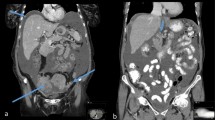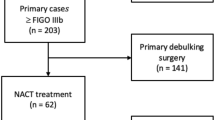Abstract
The purpose of the study was to evaluate the expression of the biomarkers CA125 and HE4 combined with imaging, in patients with advanced epithelial ovarian cancer (EOC). Forty-six women with EOC were included in the study all affected with peritoneal carcinomatosis. Twenty-two of 46 patients (group I) had peritoneal carcinomatosis with small implants in single or in multiple sites (score 1); 24/46 patients (group II) had macro-nodular implants and omental thickening (score 2). High levels of CA125 (350 ± 11, mean ± SEM) have been observed in 21/22 patients of group I, and a similar value (370 ± 13) has been observed in all patients belonging to group II. HE4 positivity values (350 ± 9) have been observed in all group I patients, whereas all patients belonging to group II showed a higher value of HE4 (600 ± 12). Statistically significant differences were observed between the HE4 levels observed in group I patients in comparison with group II patients (p < 0.0001). In addition, we expressed the extension of lymph nodal disease in three scores: L1–L2–L3, and a statistically significant correlation was observed between high HE4 levels and severity of lymph nodal disease L3 (p < 0.0001). The availability of biomarkers, particularly HE4, together with sophisticated imaging techniques, strengthens the clinical relevance of this study, for the follow-up of patients with peritoneal carcinomatosis.





Similar content being viewed by others
References
Bharwani N, Reznek RH, Rockall AG. Ovarian cancer management: the role of imaging and diagnostic challenges. Eur J Radiol. 2011;78:41–51.
Woodward PJ, Hosseinzadeh K, Saenger JS. From the archives of the AFIP: radiologic of ovarian carcinoma with pathologic correlation. AFIP Archives. 2004;24:225–46.
Ozols RF. Recurrent ovarian cancer: evidence-based treatment. J Clin Oncol. 2002;20:1161–3.
Meyers MA. Distribution of intraabdominal malignant seeding: dependency on dynamics of flow of ascetic fluid. AJR Am J Roentgenol. 1973;119:198–206.
Foerstener R. Radiological staging of ovarian cancer: imaging findings and contribution of CT and MRI. Eur Radiol. 2007;17:3223–46.
Low RN. MR imaging of the peritoneal spread of malignancy. Abdom Imaging. 2007;32:267–83.
Sala E, Kataoka M, Pandit-Tasakar N, Ishill N, Mironov S, Moskowitz C, Mironov O, Collins M. Recurrent ovarian cancer: use of contrast-enhanced CT and PET/CT to accurately localize tumor recurrence and to predict patients’ survival. Radiology. 2010;257:125–34.
Tempany C, Zou K, Silverman SG, Brown DL, Kurtz AD, MacNeil BJ. Staging of advanced ovarian cancer: comparison of imaging modalities—report from the Radiological Diagnostic Oncology Group. Radiology. 2000;215:761–7.
Rosen DG, Wang L, Atkinson JN, Yu Y, Lu KH, Diamandis EP, Hellstrom I, Mok SC, Liu J, Bast Jr RC. Potential markers that complement expression of CA125 in epithelial ovarian cancer. Gynecol Oncol. 2005;99:267–77.
Bast Jr RC, Badgwell D, Marquez LR, Rosen D, Liu J, Bagerly KA, Atkinson EN, Skates S, Zhang Z, Lokshin A, Menon U, Jacobs I, Lu K. New markers: CA125 and beyond. Int J Gynecol Cancer. 2005;15:274–81.
Medeiros LR, Rosa DD, da Rosa MI, Bozzetti MC. Accuracy of CA 125 in the diagnosis of ovarian tumors: a quantitative systematic review. Eur J Obstet Gynecol Reprod Biol. 2009;142:99–105.
Tian C, Markman M, Zaino R, Ozzols RF, McGuire WP, Muggia FM, Rose PG, Spiggs D, Armstrong DK. CA-125 change after chemotherapy in prediction of treatment outcome among advanced mucinous and clear cell epithelial ovarian cancers: a Gynecologic Oncology Group study. Cancer. 2009;115:1395–403.
Verleye L, Ottevanger PB, van der Graaf W, Reed NS, Vergote I. Gynaecological Cancer Group (GCG) of European Organisation for Research and Treatment of Cancer (EORTC). EORTC-GCG process quality indicators for ovarian cancer surgery. Eur J Cancer. 2009;45:517–26.
Kirchhoff C. Molecular characterization of epididymal proteins. Rev Reprod. 1998;3:86–95.
Drapkin R, von Horsten HH, Lin Y, Mok SC, Crum CP, Welch WR, Hecht JL. Human epididymis protein 4 (HE4) is a secreted glycoprotein that is overexpressed by serous and endometrioid ovarian carcinomas. Cancer Res. 2005;65:2162–9.
Moore RG, Brown AK, Miller CM, Badgwell D, Lu Z, Allard WJ, Granai CO, Bast Jr RC, Lu K. Utility of a novel serum tumor biomarker HE4 in patients with endometrial adenocarcinoma of the uterus. Gynecol Oncol. 2008;108:196–201.
Anastasi E, Marchei GG, Viggiani V, Gennarini G, Frati L, Reale MG. HE4: a new potential early biomarker for the recurrence of ovarian cancer. Tumor Biol. 2010;2:113–9.
Chereau E, Ballester M, Rouzier R, Coutant C, Darai E. Advanced ovarian cancer: criteria of respectability. Bull Cancer. 2009;96:1189–97.
Cragun JM. Screening for ovarian cancer. Cancer Control. 2011;18:16–21.
Coakley FV, Choi PH, Gougoutas CA, Pothuri B, Venkatraman E, Ki D, Bergman A, Hricak H. Peritoneal metastates: detection with spiral CT in patients with ovarian carcinoma. Radiology. 2002;223:495–9.
Jelovac D, Armstrong DK. Recent progress in the diagnosis and treatment of ovarian cancer. CA Cancer J Clin. 2011;61(3):183–203.
Donach M, Yu Y, Artioli G, Banna G, Feng W, Bast Jr RC, Zhang Z, Nicoletto MO. Combined use of biomarkers for detection of ovarian cancer in high-risk women. Tumor Biol. 2010;31:209–15.
van der Burg ME. Advanced ovarian cancer. Curr Treat Options Oncol. 2001;2:109–18.
Vorgias G, Iavazzo C, Savvopoulos P, Myriokefalitaki E, Katsoulis N, Akrivos T. Can the preoperative Ca125 level predict optimal cytoreduction in patients with advanced ovarian carcinoma? A single institution cohort study. Gynecol Oncol. 2009;112:11–5.
Marin D, Catalano C, Baski M, Di Martino M, Geiger D, Di Giorgio A, Sibio S, Passariello R. 64-Section multidedector row CT in the preoperative diagnosis of peritoneal carcinomatosis: correlation with histopathological findings. Abdom Imaging. 2010;35:694–700.
Boone JM. Multidetector CT opportunities, challenges and concerns associated with scanners with 64 or more detector rows. Radiology. 2006;241:334–7.
Meissnitzer M, Forstner R. Radiological diagnostics of ovarian cancer. Radiologe. 2011;51:581–8.
Moore RG, Jabre-Raughley M, Brown AK, Robison KM, Miller MC, Allard WJ, Kurman RJ, Bast RC, Skates SJ. Comparison of a novel multiple marker assay vs the Risk of Malignancy Index for the prediction of epithelial ovarian cancer in patients with a pelvic mass. Am J Obstet Gynecol. 2010;203(228):e1–6.
Lutz A, Willmann J, Drescher C, Ray P, Cochran F, Urban GS. Early diagnosis of ovarian cancer: is a solution in sight? Radiology. 2011;259:329–45.
Diniz Bizzo SMD, Dummer Meira DD, Lima JM, da Silva MJ, Casali-da-Rocha JC, Faria Ornellas MH. Peritoneal VEG burden as a predictor of cytoreductive surgery outcome in women with epithelial ovarian cancer. Int J Obstet Gynecol. 2010;109:113–7.
Kang S. The role of neoadjuvant chemotherapy in ovarian cancer patients with extensive tumor burden. JgO. 2011;22:299–300.
Acknowledgments
This study is funded by the University of Rome “Sapienza”. We are thankful to Giuseppina Gennarini, Barbara Colaprisca, Silvestra Tudini and Pasqualina Moro for their technical assistance.
Conflicts of interest
None
Author information
Authors and Affiliations
Corresponding author
Additional information
Emanuela Anastasi and Teresa Granato contributed equally to this work.
Rights and permissions
About this article
Cite this article
Midulla, C., Manganaro, L., Longo, F. et al. HE4 combined with MDCT imaging is a good marker in the evaluation of disease extension in advanced epithelial ovarian carcinoma. Tumor Biol. 33, 1291–1298 (2012). https://doi.org/10.1007/s13277-012-0376-5
Received:
Accepted:
Published:
Issue Date:
DOI: https://doi.org/10.1007/s13277-012-0376-5




